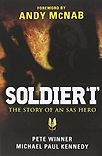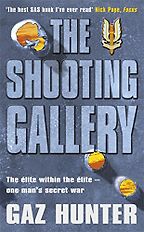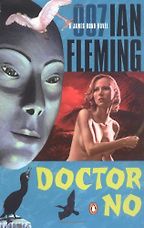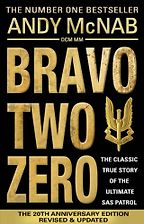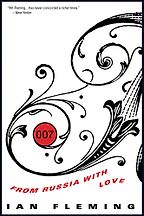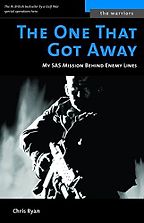You’ve just finished reading The Shooting Gallery by Gaz Hunter.
Yes, obviously Gaz Hunter is a pseudonym. I know the guy well, I know his name but I am not going to mention it here. He did quite a lot of service in the SAS, he’s very experienced. He was at the Waco Texas massacre where the cult leader held all those people and eventually they burnt the place down and killed about 100 of them. It was a terrible event and he was there as an adviser. He also left the SAS for a while and went to Afghanistan to train the Mujahideen and he ended up on the frontline with them fighting the Russians in the early 1980s.
So with this book, The Shooting Gallery is a nickname. He was in the Green Jackets when he was a young soldier and he was in Northern Ireland when things were pretty hot in the 1970s in Londonderry. Because they were always getting shot at they called their camp ‘the shooting gallery’. But he doesn’t just talk about Ireland; there are lots of other interesting things in the book as well.
With regards to espionage, he writes in detail about the regiment’s involvement in going over the East German border into the Russian-occupied East Germany and doing surveillance on Russian installations and spotting where equipment was being stored. So there was lots of covert driving about at night which makes it all very interesting stuff.
But is he giving secrets away, because I know that in your book, Soldier ‘I’, you are very conscious of not giving anything away and protecting your code of conduct?
I must admit I hadn’t read about that side of the regiment’s work in a book before this but then again the Berlin Wall has come down so he isn’t giving any active secrets away. This is about the past, things like looking at how they could spot equipment even though it was covered in tarpaulin.
I know you are a big Ian Fleming fan so let’s talk about your second choice, Doctor No, which was one of your early inspirations.
Well, this is the one where James Bond has to go out to Jamaica and investigates the disappearance of Strangways, the head of Station J in Kingston. What I really like about all his books is the attention to detail. It was all based on his experiences when he worked for naval intelligence during the war. He could use terminology like Sit Rep. Many people had never heard of Sit Rep before but in Special Forces if you want to know what’s going on in a place you ask for a Sit Rep, which means a situation report. And then there is all the specialised equipment which you can get from Q. We have the same set-up in the SAS called Ops Research, where all new gadgets are tested and demonstrated and taken out into the field to be used, so he really was writing from real life experience.
How did he inspire you?
Well, it didn’t make me want to be in M16. You have to be pretty intelligent and a public school boy for that. I just had a standard education. But it certainly inspired me to want to go out and have an adventure. When I first heard of the SAS when I was out in the Middle East in the 1960s it sounded as near to that kind of James Bond lifestyle that you could get.
Your next book is Bravo Two Zero, which is written by a friend of yours, Andy McNab.
This is an excellent book all about survival. That is the survival of the human spirit against adversity. When the chips were down Andy and the other men with him had to escape and evade detection across hundreds of miles of open desert in the extreme cold before they could get to safety. And they weren’t really equipped for that kind of harsh weather.
What happened was they were sent behind enemy lines to do what we call an OP, which means an observation post on an MSR – main supply route. They were really looking for the movement of Scud missiles because you can put a launcher on an articulated truck and it moves across the desert. Unfortunately, they were dropped off in the dark and when it became light they saw that they were practically on top of an Iraqi position. So they were compromised and the balloon went up and they had to what we call bug out, which is when you have to get all your equipment together rather sharpish and make a run for it!
Get the weekly Five Books newsletter
They made a run for it and it was a good few days before they made it to safety. All the time they were being pursued across the Iraqi desert in vehicles and Andy and his gang had to escape and evade, which we are trained to do as part of our SAS selection. With lesser men, the whole lot of them probably would have died. As it was, one of the guys froze to death but nearly all the rest either escaped or were captured. In Andy’s case, he was captured and tortured and held until the Iraqis ran the white flag up. So this is a real survival story. The guys who escaped and are alive today had all done SAS selection and were fit guys so they are around today to tell the story.
I know that many of you from the SAS say that it is really impossible for civilians to understand the type of situations you go through, but can you try and describe what it is like.
Well, I’ve never had to escape and evade but other hardships are things like when you are on a mission like one I had of retaking a plateau where I was in the full heat of Arabian nights. It was hot at night and during the day it gets up to 40 degrees. There isn’t enough water and then on top of that you are lugging all this really, really heavy equipment about – normally uphill.
It’s again another survival of the fittest exercise. If you’re not fit you’re not going to get up there and you will be left behind. The SAS being a macho organisation, you don’t want to let your mates down.
Let’s get back to your other Ian Fleming choice, From Russia With Love.
Well, this is all about the Cold War. It is a similar story to what Gaz Hunter was into – going across the East German border, lurking around, possibly getting captured and tortured by the Russians. There was just stuff in there that really grabbed my attention. For example, when they were being covertly filmed while they were making love in the hotel. That is stuff that can be used against you.
Do you have honey traps in the SAS?
It has been known and, of course, there are some willing locals around Hereford where the SAS are based. Did you know that an old nickname for the SAS is Sex and Suntans?!
Is there the same type of glamour in the SAS that you find in the James Bond books?
When you are getting bitten by mosquitoes in some stinking jungle or dying of thirst there is no glamour there. But there is, of course, the pride in being part of the élite and there are glamorous jobs when you get taken out of the jungle and find yourself bodyguarding the British Ambassador of Kabul. The SAS look after him.
And when you left the SAS and worked for one of the private security firms, who are part of the circuit of ex-SAS people, you had some pretty glamorous jobs.
Yes, I once had to look after £90 million-worth of diamonds in two briefcases with a friend. I thought we would have an armoured car and protection, but no. They belonged to the Sultan of Brunei and they were a present for his brother. So I was sat in first-class in British Airways with £45 million-worth of jewels stuffed under my seat.
Your final book is by Chris Ryan, The One That Got Away.
Yes, this is about the same event as Andy’s book but, as the title suggests, he was the one who managed to escape. And this is another illustration of the human spirit and what SAS guys have to put up with. In fact, he has now got the record for the longest escape and evasion in the SAS, which was previously held by someone in the Second World War who did a similar thing in the Western Desert.
Five Books interviews are expensive to produce. If you're enjoying this interview, please support us by donating a small amount.
So, he was part of the Bravo 2 Zero patrol and when they had to bug out they were laying up during the day and marching at night. Chris Ryan eventually somehow got detached from the rest of the group in a blizzard. He wandered off and got lost. You have to remember this is during some of the worst weather they had had for 30 years. He went it alone and decided to go for the Syrian border and, by sheer luck, in the end he made it and crossed the border to freedom. I think it shows a huge amount of spirit and stamina.
What’s the atmosphere like when people come back from missions like that when you think they had died?
Well, it’s typical SAS – let’s get down the pub and get pissed. Once you are on the booze you can tell us the story down there! So that is basically what happens.
Was it a similar deal when you were celebrating your successful mission to release the hostages from the Iranian Embassy in London and Margaret Thatcher came to visit you?
Yes, it was pure exhilaration. You realise what a great success you have made of an operation. I would imagine Chris would have felt exhilarated to have escaped being captured and tortured. After the siege it was a different kind of exhilaration. Maggie Thatcher walked in to see us, like Caesar returning to the Senate. She said, ‘There is nothing sweeter than success and you boys have got it.’ And we all went, ‘Yeah, come and have a drink, Maggie.’ And she did. And then John, who was one of the guys on the balcony at the embassy, wanted to watch the news, and she was wandering about, so he shouted at her: ‘That woman at the front sit down!’ And she did, cross-legged in front of the TV so we could all watch our success on the news.
Five Books aims to keep its book recommendations and interviews up to date. If you are the interviewee and would like to update your choice of books (or even just what you say about them) please email us at [email protected]

